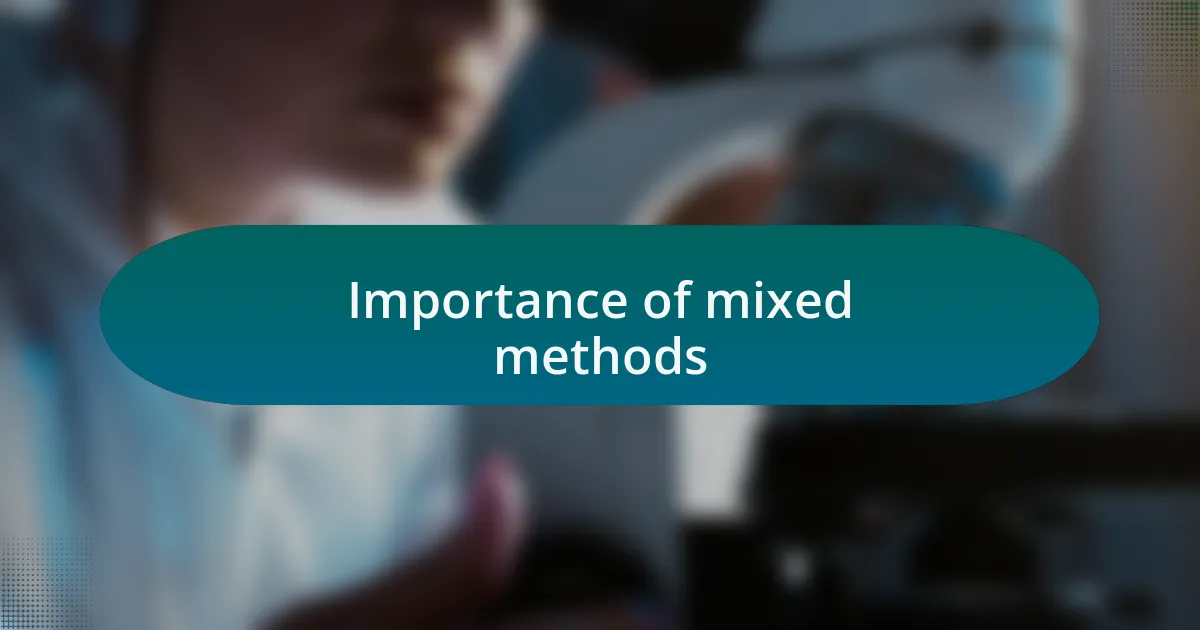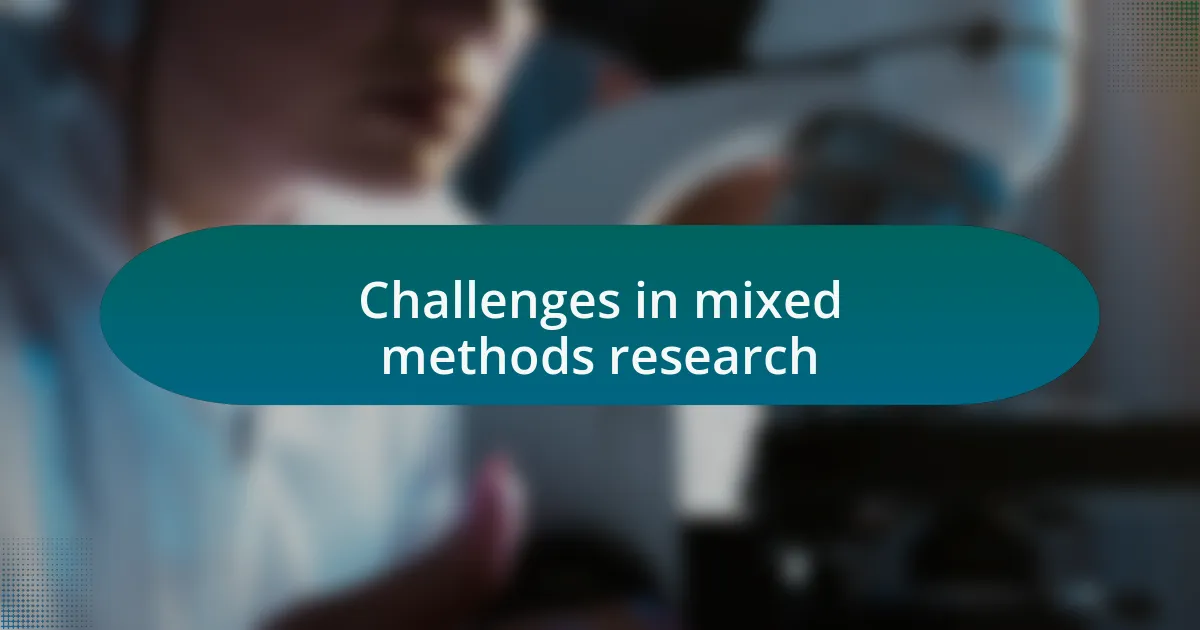Key takeaways:
- Mixed methods research combines qualitative and quantitative approaches for a deeper understanding of complex human experiences.
- This approach allows for validation through triangulation, providing more robust insights and fostering richer discussions.
- Designing a mixed methods study requires careful planning, clear research questions, and strategic data collection timing.
- Challenges include reconciling conflicting data, time management, and the need for expertise in both methodologies.

Understanding mixed methods research
Mixed methods research blends qualitative and quantitative approaches, creating a more comprehensive understanding of a research problem. I remember my first encounter with this approach; it felt like a revelation to combine numbers with people’s stories. It opened up a new dimension, allowing me to see not just what happened but also why it happened.
I often find myself asking, how can we fully grasp the complexity of human experiences if we rely solely on one method? This question drove me to explore mixed methods in my work. By combining surveys with in-depth interviews, I discovered richer insights about participant attitudes that numbers alone couldn’t capture.
Engaging in mixed methods research requires careful planning and a genuine curiosity about the topic. It’s not just about collecting data; it’s about weaving together different strands of information to form a cohesive narrative. I’ve found that this approach not only enriches the data but also invites deeper conversations about the findings, forming a bridge between statistical trends and human experiences.

Importance of mixed methods
Mixed methods research is crucial because it captures the complexity of real-world issues. I remember a project where quantitative data showed a declining trend, but interviews revealed underlying factors of community dissatisfaction. It was the fusion of those numbers and narratives that painted a complete picture, highlighting the need for deeper investigation.
One of the most important aspects of using mixed methods is the ability to validate findings through triangulation. During my research, I experienced moments of clarity when data from different sources aligned. It made me wonder: how often do we miss significant truths by only looking at one side of the story? This validation gives researchers greater confidence in their conclusions, fostering a more robust discussion around the results.
Moreover, mixed methods allow researchers to approach questions from multiple angles, enriching the analysis. In one instance, I combined focus group feedback with statistical surveys, leading to unexpected insights about user behavior. I often think about the opportunities missed when we don’t explore beyond numbers or singular narratives—mixed methods remind us that the story is often deeper than the data suggests.

Designing a mixed methods study
Designing a mixed methods study requires careful consideration of how to blend qualitative and quantitative approaches seamlessly. In one project, I faced the challenge of deciding whether to collect survey data first or conduct interviews. This choice significantly impacted how I interpreted the data later. Have you ever noticed how the order of operations can shift your perspective?
When crafting your study, it’s essential to define clear research questions that guide both the qualitative and quantitative components. I recall a time when I had vague questions, and it felt like navigating without a map. Once I refined my questions, the entire design process became more focused and purposeful, allowing me to effectively connect the dots between the two methods.
Finally, consider the timing and integration of your data collection. In my experience, parallel data collection can offer immediate insights, while sequential designs might reveal how one method informs the other. This strategic approach not only enhances the depth of analysis but also sparks those “aha” moments that can redefine the meaning of your findings. Have you thought about how different data collection timelines could influence your results? It’s a fascinating consideration in the realm of mixed methods.

Analyzing mixed methods data
When analyzing mixed methods data, it’s crucial to approach both qualitative and quantitative findings with a mindset geared toward integration. I remember wrestling with vast amounts of data that, on the surface, seemed unrelated. Yet, once I began to look for patterns, connections emerged that transformed my understanding of the subject. How often do we overlook valuable insights buried within our data?
One effective strategy for analysis is triangulation, which involves comparing results from different methods to validate findings. In my past projects, applying this technique often led to compelling narratives that enriched my conclusions. For instance, I once discovered that survey results pointed toward one trend, but the interviews revealed deeper, contextual reasons behind those numbers, creating a more holistic view. Isn’t it fascinating how different lenses can uncover the complexity of human behavior?
Finally, I found that reflecting on your biases during analysis is vital. I recall a time when my personal beliefs unintentionally colored my interpretation of qualitative data, which skewed the outcomes. By regularly questioning my assumptions and considering alternative perspectives, I learned to approach my analysis with greater objectivity and depth. Have you taken a moment to consider how your worldview impacts your research? This reflection can lead to richer, more meaningful insights.

Challenges in mixed methods research
Navigating mixed methods research can often feel like traversing a labyrinth of complexity. One major challenge I faced during my early projects was reconciling conflicting results from qualitative and quantitative data. For instance, while my surveys indicated a high level of satisfaction, the focus group discussions unveiled a stark contrast, exposing underlying grievances. Have you ever felt that push and pull between numbers and narratives? It can be disheartening to sift through such contradictions, yet they often hold the key to a richer understanding.
Another hurdle is the time-consuming nature of working with mixed methods. In my experience, designing and conducting research that effectively captures both qualitative nuances and quantitative breadth can stretch timelines more than expected. I remember a project where I underestimated how long it would take to thoroughly analyze interview transcripts alongside statistical data. Have you ever miscalculated your research timelines? It’s a frequent pitfall, one that reminds me of the importance of detailed planning and flexibility in approach.
Moreover, the need for expertise in both qualitative and quantitative methods can be daunting. I often find myself reflecting on instances where I felt out of my depth, trying to balance different methodologies. Learning to be proficient in both realms demands continuous education and can leave researchers feeling overwhelmed. How often do we wish we could specialize in one area and still achieve our research goals? Embracing this duality, while challenging, opens the door to a more comprehensive exploration of complex research questions.